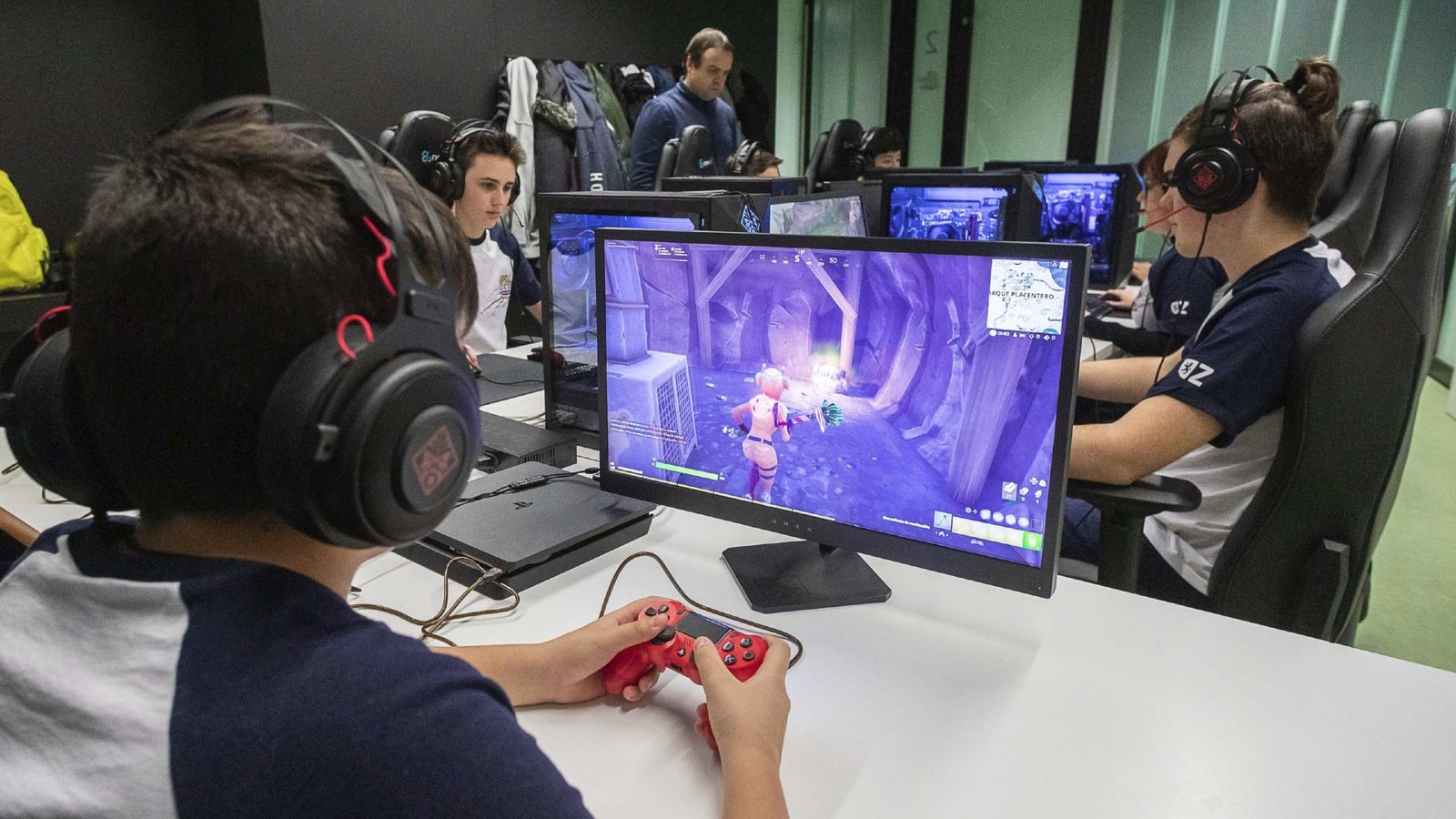The Best Gaming Monitors for 2023

Discover the Best Gaming Monitors for 2023, elevating your gaming experience with immersive visuals and cutting-edge technology. The gaming monitor is at the heart of this revolution—a gateway to immersive worlds, thrilling adventures, and pulse-pounding action. In this article, we embark on a journey through the realm of gaming monitors, exploring their pivotal role in shaping our gaming experiences, enhancing visual fidelity, and providing us with an unprecedented level of engagement.
From the early days of blocky graphics and limited color palettes to the cutting-edge displays of today, gaming monitors have undergone a remarkable transformation. They’ve evolved alongside the games, accommodating the demands of ever-expanding virtual universes and pushing the boundaries of what’s possible in visual storytelling. Whether you’re a competitive esports aficionado, an RPG enthusiast lost in sprawling narratives, or a casual player seeking moments of escapism, the monitor is your portal into these digital realms.
So, whether you’re a veteran of countless battles or a newcomer eager to discover new worlds, fasten your seatbelt as we embark on this journey. The world of gaming monitors is a realm of innovation, creativity, and limitless potential, where each pixel is a brushstroke in the masterpiece of your gaming adventure. Get ready to dive into the pixels and uncover the secrets that make gaming monitors not just screens but windows into the extraordinary.
Read more: Exploring the World’s Best Gaming in 2023
The Crucial Role of Gaming Monitors
Gaming monitors are more than just screens; they’re windows into virtual worlds, portals that can transport players into breathtaking realms of action, adventure, and competition. With gaming evolving rapidly, monitors have kept pace, offering features tailored to the needs of different types of gamers. Whether you’re a competitive esports enthusiast, a role-playing game connoisseur, or a budget-conscious player, there’s a monitor designed to enhance your experience.
Factors to Consider When Choosing a Gaming Monitor

When you’re in the market for a gaming monitor, several factors come into play, each influencing the overall experience. Here are some key considerations to keep in mind:
Display Technology: LED, OLED, and More
The display technology impacts color accuracy, contrast, and brightness. LED monitors are popular for affordability, while OLED monitors provide deeper blacks and richer colors.
Refresh Rate and Response Time
A higher refresh rate results in smoother motion, reducing blur in fast-paced games. Coupled with a low response time, you’ll experience seamless gameplay without ghosting.
Resolution: Full HD, 4K, and Beyond
The resolution affects image clarity. Full HD (1920×1080) is standard, but 4K (3840×2160) offers more detailed visuals. Consider your graphics card’s capabilities when choosing a resolution.
Panel Type: TN, IPS, and VA
Panel types influence viewing angles and color accuracy. TN panels have fast response times, IPS panels offer vibrant colors and wider angles, while VA panels strike a balance between the two.
Top Gaming Monitors for Competitive Gaming
ASUS ROG Swift PG279Q
The ASUS ROG Swift PG279Q is a favorite among competitive gamers. It balances speed and visual quality with a 1440p resolution, 165Hz refresh rate, and IPS panel.
Alienware AW2721D
Alienware’s AW2721D boasts a 240Hz refresh rate and 1440p resolution, making it ideal for esports enthusiasts. Its fast response time ensures you’re always a step ahead.
Immersive Gaming Monitors for RPG Enthusiasts

LG UltraGear 38GN950-B
For RPG lovers, the LG UltraGear 38GN950-B offers a vast 38-inch ultrawide curved display with a 144Hz refresh rate. Lose yourself in expansive landscapes and intricate details.
Samsung Odyssey G9
The Samsung Odyssey G9 is a curved behemoth with a 49-inch display, 240Hz refresh rate, and HDR support. It’s a visual marvel that pulls you into every gaming universe.
Budget-Friendly Gaming Monitors
AOC C24G1
If you’re on a budget, the AOC C24G1 delivers a 1080p resolution, 144Hz refresh rate, and an immersive curved VA panel—all without breaking the bank.
ViewSonic XG2402
The ViewSonic XG2402 offers smooth gameplay with a 144Hz refresh rate and Full HD resolution. It’s a budget-friendly option that doesn’t compromise on performance.
Curved vs. Flat Monitors: Which is Right for You?
In the quest for the perfect gaming setup, gamers often face one crucial decision: whether to go for a curved or flat monitor. The debate has divided the gaming community, with passionate advocates on both sides. Each monitor type has its merits and can greatly impact your gaming experience. So, which one should you choose? Let’s delve into the world of curved and flat monitors to help you make an informed decision.
The Curved Monitor Experience
Curved monitors have gained popularity due to their immersive feel. The gentle curvature of the screen mimics the natural shape of your eyes, offering a more uniform viewing distance across the entire display. This curvature aims to create a panoramic effect that wraps the visuals around you, pulling you deeper into the gaming world.
Imagine embarking on an epic journey through an open-world game, where the curvature of the monitor enhances the feeling of being surrounded by the game’s environment. Curved monitors are particularly effective in large displays, like ultrawide models, where the curve can help maintain consistent image quality across the wide expanse of the screen.
However, it’s important to note that the degree of curvature matters. More pronounced curves might be better suited for larger displays, while mild curves work well for smaller screens, striking a balance between immersion and comfort.
The Flat Monitor Advantage
On the other hand, flat monitors maintain a more traditional and straightforward design. They offer a consistent viewing experience without any curve distortion. This makes flat monitors well-suited for competitive gaming, where precise visual accuracy is essential. Flat monitors are also more versatile in placement and tend to have a wider optimal viewing angle.
A flat-monitor can be a game-changer when playing fast-paced games requiring quick reflexes and pinpoint accuracy. The absence of curvature ensures that lines and edges remain straight, which can be particularly beneficial in FPS and esports titles. Flat monitors are often more affordable, making them an attractive option for budget-conscious gamers.
Making the Right Choice
Ultimately, choosing between a curved and a flat monitor boils down to your preferences and the types of games you enjoy playing. If you’re drawn to immersive experiences and open-world adventures, a curved monitor might offer that enveloping feel you’re looking for. On the other hand, if you’re focused on competitive gaming and need precise visuals, a flat monitor could be the better fit.
Remember to consider the size of the monitor, the curvature level, and your gaming environment. Trying out both types of monitors in a store or at a friend’s place can also help you better understand what suits your preferences.
Ultra-Wide Gaming Monitors: Expanding Your Horizon
Gaming is more than just a pastime; it’s an immersive experience that transports us to new worlds and challenges us in ways we never thought possible. As technology continues to push boundaries, so does the world of gaming monitors. Enter the realm of ultra-wide gaming monitors—a trend transforming how we perceive and engage with our favorite games.
Embracing a Wider Perspective
Imagine stepping into a virtual realm where your field of view extends beyond the confines of a standard monitor. That’s the magic of an ultra-wide gaming monitor. With a wider aspect ratio—typically 21:9 or even wider—these monitors offer a panoramic view that mimics the natural span of human vision. This expanded field of view isn’t just visually impressive; it’s a game-changer in gameplay.
In action-packed titles like first-person shooters and racing games, ultra-wide monitors grant you an edge. You’ll spot enemies sneaking up from the sides, anticipate turns more accurately, and immerse yourself in breathtaking landscapes that stretch as far as the eye can see. It’s an advantage that can mean the difference between victory and defeat.
The Power of Immersion
Gaming is about immersion—losing yourself in the narrative, the challenges, and the worlds you explore. Ultra-wide monitors take immersion to the next level. Whether traversing the dense jungles of a fantasy RPG or navigating the stars in a space exploration game, the extended horizontal space engulfs you in the environment. You’re no longer just a player but a part of the digital universe.
This level of immersion is particularly pronounced in simulation games like flight simulators or city builders. The widescreen accommodates complex control panels, expansive cityscapes, and intricate details without cramming you. It’s as close to stepping into the game as you can get.
Multi-Tasking Made Effortless
Ultra-wide monitors aren’t limited to gaming—they’re productivity powerhouses too. Imagine seamlessly working on a document while having a browser open side by side without constantly switching between windows. The extra horizontal space allows for efficient multitasking, making ultra-wide monitors a versatile addition to your workspace.
The Technical Marvel
The technology behind ultra-wide monitors is as impressive as the experience they deliver. High resolutions, fast refresh rates, and features like High Dynamic Range (HDR) bring visuals to life with stunning clarity and vibrancy. The curve of the screen, often found in these monitors, further enhances the immersive effect by wrapping the display around your vision.
Is It for You?
Before diving into ultra-wide gaming monitors, consider your gaming preferences and setup. If you’re an enthusiast of fast-paced action, open-world exploration, or simulation games, an ultra-wide monitor can be a game-changer. However, some games might not fully support the ultra-wide aspect ratio, leading to letterboxing or distorted visuals.
Also, ensure that your graphics card can handle the increased pixel count of an ultra-wide monitor, especially if you’re aiming for higher resolutions like 1440p or 4K. It’s essential to balance a smooth gaming experience and stunning visuals.
Expanding Horizons, Elevating Gameplay
Ultra-wide gaming monitors have proven to be more than just a passing trend. They’re a testament to the evolving landscape of gaming technology, inviting players to step beyond the boundaries of the screen and embrace a wider perspective. Whether seeking a competitive edge, a deeper immersion, or a versatile workstation, an ultra-wide monitor can revolutionize your gaming and computing experience.
So, if you’re ready to explore new dimensions and expand your gaming horizons, an ultra-wide gaming monitor might be the perfect addition to your setup. It’s a window to new worlds within games and a future where gaming experiences are more captivating and enveloping than ever before.
High Dynamic Range (HDR) and Its Impact on Gaming

In the ever-evolving gaming world, one technology has emerged to reshape how we experience virtual worlds: High Dynamic Range (HDR). With its ability to enhance contrast, color accuracy, and overall visual quality, HDR is literally changing the game. In this article, we’ll explore the concept of HDR, its significance, and how it’s revolutionizing how we perceive and play our favorite games.
Unveiling the Magic of HDR
At its core, High Dynamic Range (HDR) is all about delivering a broader range of colors and luminosity levels on your screen. Unlike the standard dynamic range, which can sometimes lead to washed-out highlights and overly dark shadows, HDR aims to replicate the human eye’s dynamic range. This means you’ll experience more vivid colors, brighter whites, and deeper blacks, resulting in visuals that are closer to reality.
Imagine playing a game where sunlight pierces through the dense foliage of a forest, casting intricate shadows and illuminating every leaf and dewdrop. With HDR, these scenes come alive with detail and contrast previously unattainable. From fiery explosions to subtle glimmers of light, HDR enhances the visual storytelling of games, pulling you deeper into the virtual worlds you explore.
A New Dimension of Immersion
Gaming is all about immersion—being transported to new realms and losing yourself in epic narratives. HDR takes this immersion to the next level by adding depth and dimension to every pixel. The increased contrast range means you can distinguish details in the screen’s brightest and darkest parts, creating a sense of realism that’s hard to match.
In horror games, for instance, HDR amplifies the tension as dimly lit corridors and pitch-black corners become more foreboding. Conversely, vibrant and colorful fantasy landscapes burst forth with life and vibrancy, making you feel like you’re truly stepping into another world.
HDR and Gaming’s Artistic Potential
HDR isn’t just about technical advancements; it’s also a tool that empowers game developers to unleash their creativity. With the expanded color palette and contrast options, game creators can craft more visually striking environments, emphasize mood and atmosphere, and imbue their worlds with cinematic quality.
From the serene beauty of a sunset over a virtual cityscape to the ethereal glow of alien bioluminescence, HDR allows games to evoke emotions and reactions in players like never before. It’s not just about realism; it’s about artistic expression and the ability to create visuals that resonate on a deeper level.
The Hardware and Software Equation
To fully appreciate the benefits of HDR in gaming, you’ll need both compatible hardware and HDR-enabled content. This means having a monitor or TV that supports HDR and a graphics card capable of delivering the necessary processing power. Additionally, the game must be developed with HDR, utilizing the expanded color and luminosity range to its fullest potential.
The HDR Revolution
High Dynamic Range (HDR) is more than just a buzzword; it’s a technological leap redefining how we experience gaming visuals. HDR adds realism, depth, and emotional impact to our gaming experiences by offering a more accurate representation of real-world lighting conditions. From epic battles to quiet moments of reflection, HDR allows us to see games in a new light—brighter, more vibrant, and undeniably captivating.
So, as you embark on your gaming adventures, take a moment to appreciate the stunning visuals that HDR brings to the table. It’s a reminder that technology isn’t just about numbers and specs; it’s about enhancing the magic of gaming and allowing us to explore virtual worlds with a sense of wonder and awe.
Read more: The Ultimate Gaming Accessories Guide in 2023
Monitor Calibration: Unlocking True Visual Fidelity

In gaming and digital media consumption, the quality of visuals is paramount. Every pixel, shade, and hue matters as they collectively shape the immersive experience we cherish. Yet, achieving true visual fidelity is more intricate than it may seem. This is where monitor calibration steps in—a process that holds the key to unlocking the full potential of your display. In this article, we’ll explore the art and science of monitor calibration, understand its significance, and how it can elevate your gaming and viewing experiences.
The Quest for Accurate Colors
Have you ever noticed that a photo or a game looks different on various devices or screens? This discrepancy stems from the differences in color rendering and calibration across devices. Monitor calibration bridges this gap by ensuring that the colors you see on your screen match the intended colors as closely as possible. Essentially, it’s a process that fine-tunes your monitor to display colors accurately according to established standards.
The Calibration Process
Calibrating a monitor involves adjusting various settings, including brightness, contrast, gamma, and color balance. Specialized tools, such as colorimeters and spectrophotometers, measure the display’s performance and guide the calibration process. Additionally, calibration software helps you make precise adjustments based on the measured data.
The goal is to create a color profile that accurately represents the colors that images and games were designed to display. This profile is stored in the monitor or your computer’s graphics card, ensuring consistent and accurate color reproduction across different content.
Unlocking the Gaming Advantage
Monitor calibration isn’t just about achieving accurate colors; it’s also about gaining a competitive edge in gaming. Calibrated monitors provide a clear and balanced representation of the game’s visuals, allowing you to spot enemies, details, and nuances that might otherwise be lost in the fray.
A calibrated monitor can differentiate between victory and defeat in fast-paced games, where split-second decisions matter. The right balance of brightness, contrast, and color accuracy can enhance visibility and immersion, enabling you to react swiftly and strategically to in-game situations.
The Cinematic Experience
Beyond gaming, monitor calibration enhances the cinematic experience when watching movies or videos. Calibrated monitors reproduce films as directors intended, preserving the integrity of scenes, colors, and lighting. This means you can appreciate the full spectrum of emotions conveyed through visuals—whether it’s the vibrant hues of an animated world or the nuanced shades of a dramatic scene.
Your Personalization Touch
Monitor calibration isn’t a one-size-fits-all process. It’s an opportunity to personalize your display to match your preferences. You can adjust color temperature, saturation, and other settings to create a visual environment that aligns with your tastes while adhering to accuracy standards.
The True Visual Journey
In a world where visuals are integral to our digital experiences, monitor calibration is a gateway to authenticity. It’s a way to honor the artistry of games, movies, and images by viewing them as they were intended to be seen. It’s a step toward a more immersive, accurate, and engaging digital world.
If you’re passionate about gaming, media, or simply appreciating the beauty of visual art, consider delving into the realm of monitor calibration. Unlock the true potential of your display, and embark on a journey where every pixel tells a story with clarity, precision, and fidelity.
The Future of Gaming Monitors: What to Expect Beyond 2023

As we stand on the cusp of technological advancement, the world of gaming is poised for a transformative journey that promises to reshape how we perceive and interact with virtual worlds. Beyond 2023, the horizon of gaming monitors holds exciting innovations that could redefine our gaming experiences in ways we can only imagine. In this article, we’ll peer into the crystal ball and explore the potential future of gaming monitors, unveiling the possibilities.
Resolution Revolution
The quest for higher resolutions is unceasing, and beyond 2023, we can anticipate gaming monitors pushing the boundaries further. While 4K has become a standard, we might witness the rise of 8K and even higher resolutions. The increased pixel density promises sharper, more detailed visuals and a closer to reality.
Refresh Rates and Beyond
Fluidity in motion is the essence of gaming, and future monitors will likely embrace refresh rates that exceed our current expectations. While 144Hz and 240Hz are prevalent now, we could see monitors offering 360Hz and beyond. This ultra-high refresh rate would deliver unprecedented smoothness, benefiting fast-paced games and esports enthusiasts.
Ray Tracing and Realism
Ray tracing, the technology that simulates how light interacts with surfaces, is already making waves in gaming graphics. Beyond 2023, gaming monitors could be optimized to fully harness the potential of ray tracing. This would lead to visuals that are not only breathtakingly realistic but also redefine how we perceive lighting, reflections, and shadows within games.
Flexible Displays
Foldable and flexible displays have been a fascination for years. Gaming monitors might adopt these technologies in the future, allowing you to transform your monitor from a standard aspect ratio to ultra-wide with a simple fold or unfold. This adaptability could offer gamers new ways to experience content and embrace different gaming styles.
Virtual and Augmented Reality Integration
Virtual reality (VR) and augmented reality (AR) have shown glimpses of their potential in gaming. Beyond 2023, gaming monitors might seamlessly integrate with VR and AR technologies, blurring the lines between the physical and virtual worlds. Imagine a monitor transitioning from a standard display to a VR headset, offering an all-encompassing experience.
Mind-Blowing Color Accuracy
Color accuracy is a cornerstone of visual fidelity. Future monitors could achieve levels of color accuracy that mirror real life with precision. This would elevate gaming experiences and impact creative industries like design and animation, allowing professionals to work with colors that are true to life.
Holographic Displays
While currently in science fiction, holographic displays could become a reality in the future of gaming monitors. These displays project three-dimensional images without the need for special glasses or headsets, immersing gamers in a world that seemingly extends beyond the confines of the screen.
Read more: The Ultimate Gaming Accessories Guide in 2023
Conclusion
In the ever-evolving realm of gaming monitors, the journey from pixels to immersive experiences has been nothing short of extraordinary. We’ve explored the role of these displays in elevating our gaming adventures, from the battlefields of competitive gaming to the breathtaking landscapes of RPGs. Throughout this article, we’ve dived into the technology that breathes life into our virtual worlds—the captivating curves of curved monitors, the expansive vistas of ultra-wide displays, the vibrant hues of HDR, or the precision of calibration.
As we look ahead, the future of gaming monitors promises to be a symphony of innovation and imagination. The potential is boundless, from higher resolutions that redefine detail to refresh rates that immerse us in fluidity and from the integration of VR and AR to the allure of holographic displays. We’re on the cusp of a new era where technology and creativity intertwine to sculpt gaming experiences that challenge our senses and transport us to uncharted territories.
As you navigate the world of gaming monitors, remember that each choice you make, from curved to flat, from ultra-wide to standard, contributes to the unique tapestry of your gaming journey. Embrace the technology, explore the possibilities, and let your gaming monitor be the portal to countless adventures, where pixels become dreams, and every frame is a brushstroke on the canvas of your imagination.
FAQs
1. Are gaming monitors compatible with consoles like PlayStation and Xbox?
Yes, most gaming monitors are compatible with consoles, offering HDMI ports for easy connectivity.
2. Can I use a high-refresh-rate monitor for non-gaming tasks?
Absolutely! High refresh rates can make general computer usage smoother and more enjoyable.
3. What’s the advantage of an ultrawide monitor for gaming?
Ultra-wide monitors provide a wider field of view, enhancing game immersion and situational awareness.
4. Is G-Sync or FreeSync more important for gaming?
Both technologies reduce screen tearing and stuttering, so the choice depends on your graphics card brand.
5. Do I need a 4K monitor for gaming, or is 1080p sufficient?
It depends on your preferences and hardware. 4K offers higher detail, but 1080p can provide smoother performance on mid-tier GPUs.












One Comment